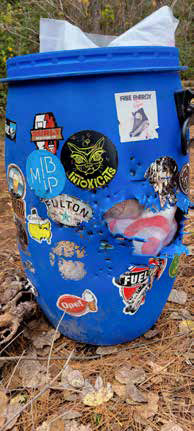As lakes and trails become snow and ice free, recreation on the Superior National Forest (SNF) increases for adventurers of all ages to enjoy. Thus, SNF wildlife managers remind visitors to not only be considerate of other visitors but also the diverse wildlife species that call the SNF their home. This spring, learning and practicing Bear Aware principles while enjoying the SNF is important for both visitors and bears. Black bears are now active across the landscape, often with several cubs hungrily looking for food after a winter of hibernation.
Last year was a banner year for natural bear forage across the State of Minnesota – berries and acorns in particular were abundant. Thus, biologists and the public are seeing increased cubs this spring with their mothers (sows) in search of food after hibernating during the winter months.
Securing and storing food properly are the most important steps visitors need to take while recreating on the SNF. To reduce the potential for unwanted bear encounters when camping or picnicking on the SNF, ALL food, cooking equipment, and garbage should be stored out of reach of bears or in a certified bear-resistant container. Be aware that bears may also find anything with a strong or sweet odor attractive such as toothpaste, lip balm, scented personal products, sunscreen, clothing with food odor, etc. A bear can smell food wrappers inside a tent. A clean campsite is much less likely to catch the attention of bears in the area. Bears are excellent swimmers; so, precautions must be taken on island sites as well.
Help protect yourself; learn and practice these important precautions: • After each meal, the dishes should be washed immediately at least 200 feet away from the sleeping area and water source. Consider a small collapsible pail to help carry water. Keep camp stoves away from the tent area.
• Toiletries, food and garbage should be placed in a certified bear-resistant container. The Interagency Grizzly Bear Committee (IGBC) has a certified list of products (https://igbconline.org/ programs/bear-resistant-products/). “Blue barrels” have been proven to not be bear resistant and are not on the certified list. Additionally, it is best to suspend the food container out of reach by hanging it from a high line between two trees or by using the one tree method (see diagrams at end). The container should be located at least twelve feet above ground and at least six feet from the trees on either side. Protect the trees in the process with wide flat straps.
• If in a dispersed site or developed campground, it is best to store these items in a hard-sided vehicle.
• Do not count on a cooler to protect your food, unless it is on the IGBC Certified Bear Resistant Products List (see link above). Most coolers are not bear-resistant containers, but some can be modified for bear resistance (see link above). Bears can smell bottled beverages and food in plastic coolers from a few miles away. Once a bear is rewarded with food or something sweet in one cooler or tent, it learns to bite and tear into other tents and coolers.
• Dispose of fish remains by traveling at least 200 feet away from campsites, trails, portages and shorelines.
• Avoid leaving food unguarded at the canoe/boat landing or at the end of a portage. If it is not in a bear-resistant container, it is an easy target and can train a bear to frequent high-use areas. Remember, bears swim from island to island.
• If you do encounter a bear, most will be scared off if you make noise (shout, bang pots or throw fist-sized rocks at the bear, etc.). A very persistent bear may be discouraged by spraying pepper spray into its eyes. Additionally, report any bear encounters to our local offices-we track bear-human encounters. Please report bears that have attempted to get a food source, frequently visited your area, or were undeterred by making noise.
Local residents in bear country must also be bear aware, especially those that live next to public land. Keep pet food secured in the house, remove bird feeders at night, and store garbage in a building or bear resistant trash containers. Once a bear learns that human food is easily accessible, the bear will elevate its efforts to get it, putting people and bears at risk. Once a bear has been “rewarded” by human food/ garbage, it will likely continue to seek it out, so prevention is key. Often these bears must then be destroyed due to human negligence.
Superior National Forest Wildlife Biologist, Cheron Ferland, said “that 95 percent of bear-human interactions involve food or “smellables,” like sunscreen or toothpaste. Bears can smell food more than a mile away, so proper storage is important.
Once a bear is ‘rewarded’ with human food or garbage, it is likely to become habituated and continue the behavior, which could ultimately lead to the bear being put down. Please help keep our Minnesota black bears wild!
Check out safe living and camping or hiking in bear country tips at: http://www.bebearaware.org/ For more information on certified bear resistant products and bear safety tips visit the Interagency Grizzly Bear Committee website at: Interagency Grizzly Bear Committee (IGBC) - ID, MT, WY, WA (igbconline.org)

A blue plastic food barrel is not Certified by The Interagency Grizzly Bear Committee (IGBC) Bear Resistant. This barrel was damaged by a black bear in the BWCAW in 2023. Photo courtesy of R. Bonello
.jpg)











